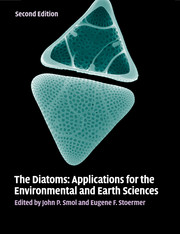Book contents
- Frontmatter
- Contents
- List of contributors
- Preface
- Part I Introduction
- 1 Applications and uses of diatoms: prologue
- 2 The diatoms: a primer
- 3 Numerical methods for the analysis of diatom assemblage data
- Part II Diatoms as indicators of environmental change in flowing waters and lakes
- Part III Diatoms as indicators in Arctic, Antarctic, and alpine lacustrine environments
- Part IV Diatoms as indicators in marine and estuarine environments
- Part V Other applications
- Part VI Conclusions
- Glossary, acronyms, and abbreviations
- Index
- References
2 - The diatoms: a primer
from Part I - Introduction
Published online by Cambridge University Press: 05 June 2012
- Frontmatter
- Contents
- List of contributors
- Preface
- Part I Introduction
- 1 Applications and uses of diatoms: prologue
- 2 The diatoms: a primer
- 3 Numerical methods for the analysis of diatom assemblage data
- Part II Diatoms as indicators of environmental change in flowing waters and lakes
- Part III Diatoms as indicators in Arctic, Antarctic, and alpine lacustrine environments
- Part IV Diatoms as indicators in marine and estuarine environments
- Part V Other applications
- Part VI Conclusions
- Glossary, acronyms, and abbreviations
- Index
- References
Summary
Introduction
Diatoms have long been lauded for their use as powerful and reliable environmental indicators (Cholnoky, 1968; Lowe, 1974). This utility can be attributed to their high abundance and species diversity, which are distributed among most aquatic environments. Additionally, their remains are highly durable and well preserved in accumulated sediments. Often, scientists exploiting the group simply as environmental proxies give little thought as to how and why the species diversity exists in these environments. This may be a by-product of how diatoms are collected and identified. Diatoms are most often recognized by the presence of a siliceous cell wall, the frustule. This structure varies considerably in shape and architecture among species (Figure 2.1) and virtually all taxonomic diagnosis of taxa is based upon frustular morphology. To properly observe diatom frustules for taxonomic identification, living and sedimentary collections are typically subjected to various “cleaning” techniques designed to remove all organic materials (e.g. Battarbee et al., 2001; Blanco et al., 2008), allowing unobstructed observation of the frustule in the microscope. This frequent observation of inorganic components of the cell without reference to the organic features allows observers to “forget” that the specimens seen in the microscope represent individual organisms competing in the selective environments driven by biotic and abiotic ecological pressures. The abundance and taxonomic diversity can be attributed to the extraordinary success of diatoms in the competitive ecological arena.
The casual observer frequently regards diatoms, like most protists, as primitive ancestral lineages to multicellular organisms. While some protists may fit this description, diatoms do not. Diatoms are a relatively recent evolutionary group with the common ancestor’s origin considered to be between 200 and 190 million years before present (Rothpletz, 1896, 1900; Medlin et al., 1997).
- Type
- Chapter
- Information
- The DiatomsApplications for the Environmental and Earth Sciences, pp. 8 - 22Publisher: Cambridge University PressPrint publication year: 2010
References
- 32
- Cited by

